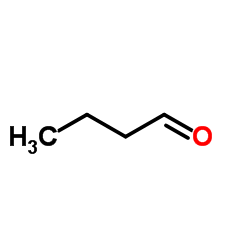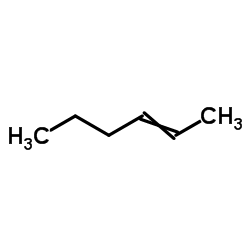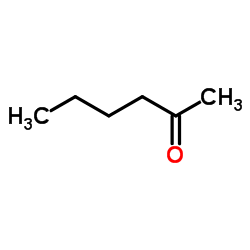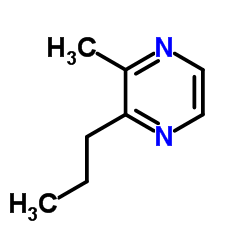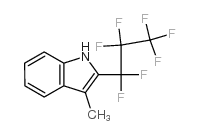3848-24-6
| 中文名 | 2,3-己二酮 |
|---|---|
| 英文名 | hexane-2,3-dione |
| 中文别名 |
乙醯丁醯
乙酰丁酰 Ω-6-十六烯酸内酯 2,3-已二酮 |
| 英文别名 |
Acetyl butyryl
hexanedione 2,3-Hexanedione EINECS 223-350-8 MFCD00009398 hexane-2,3-dione |
| 密度 | 0.9±0.1 g/cm3 |
|---|---|
| 沸点 | 125.0±9.0 °C at 760 mmHg |
| 熔点 | -30 °C |
| 分子式 | C6H10O2 |
| 分子量 | 114.142 |
| 闪点 | 32.8±4.4 °C |
| 精确质量 | 114.068077 |
| PSA | 34.14000 |
| LogP | -0.27 |
| 外观性状 | 黄色液体 |
| 蒸汽密度 | 3.9 (vs air) |
| 蒸汽压 | 12.4±0.2 mmHg at 25°C |
| 折射率 | 1.406 |
| 储存条件 | 避光,通风干燥处,密封保存 |
| 稳定性 | 常温常压下稳定,浅黄色粉末。 略带黄色油状液体。甜的浓烈的乳脂奶香,脂肪腻气比丁酮浓。发酵的大豆、啤酒、咖啡都有这一成分。微溶于水,可溶于丙二醇、乙醇和多种脂肪油类有奶油和乳酪的味道。 |
| 分子结构 | 1、 摩尔折射率:29.90 2、 摩尔体积(cm3/mol):121.8 3、 等张比容(90.2K):280.9 4、 表面张力(dyne/cm):28.3 5、 极化率(10-24cm3):11.85 |
| 计算化学 | 1.疏水参数计算参考值(XlogP):0.4 2.氢键供体数量:0 3.氢键受体数量:2 4.可旋转化学键数量:3 5.互变异构体数量:13 6.拓扑分子极性表面积34.1 7.重原子数量:8 8.表面电荷:0 9.复杂度:105 10.同位素原子数量:0 11.确定原子立构中心数量:0 12.不确定原子立构中心数量:0 13.确定化学键立构中心数量:0 14.不确定化学键立构中心数量:0 15.共价键单元数量:1 |
| 更多 | 1、性状:黄色透明液体,甜的浓烈的乳脂奶香,脂肪腻气比丁酮浓。 2、折射率(n/D20):1.411-1.413 3、闪点(℃):28 4、 熔点(℃):-30 5、沸点(ºC): 128 6、蒸汽压(mmHg,20ºC):10 7、 蒸汽密度:3.9(空气=1) 8、溶解性:微溶于水,可溶于丙二醇、乙醇和多种脂肪油类有奶油和乳酪的味道。 |
|
SECTION 1: Identification of the substance/mixture and of the company/undertaking Product identifiers Product name: 2,3-Hexanedione REACH No.: A registration number is not available for this substance as the substance or its uses are exempted from registration, the annual tonnage does not require a registration or the registration is envisaged for a later registration deadline.
CAS-No.: 3848-24-6 Relevant identified uses of the substance or mixture and uses advised against Identified uses: Laboratory chemicals, Manufacture of substances SECTION 2: Hazards identification Classification of the substance or mixture Classification according to Regulation (EC) No 1272/2008 Flammable liquids (Category 3), H226 Skin irritation (Category 2), H315 Eye irritation (Category 2), H319 Specific target organ toxicity - single exposure (Category 3), H335 For the full text of the H-Statements mentioned in this Section, see Section 16. Classification according to EU Directives 67/548/EEC or 1999/45/EC Xi IrritantR10, R36/37/38 Xi IrritantR10, R36/37/38 For the full text of the R-phrases mentioned in this Section, see Section 16. Label elements Labelling according Regulation (EC) No 1272/2008 Pictogram Signal wordWarning Hazard statement(s) H226Flammable liquid and vapour. H315Causes skin irritation. H319Causes serious eye irritation. H335May cause respiratory irritation. Precautionary statement(s) P261Avoid breathing vapours. P305 + P351 + P338IF IN EYES: Rinse cautiously with water for several minutes. Remove contact lenses, if present and easy to do. Continue rinsing. Supplemental Hazardnone Statements Other hazards - none SECTION 3: Composition/information on ingredients Substances Synonyms: Hexane-2,3-dione Formula: C6H10O2 Molecular Weight: 114,14 g/mol CAS-No.: 3848-24-6 EC-No.: 223-350-8 Hazardous ingredients according to Regulation (EC) No 1272/2008 ComponentClassificationConcentration Hexane-2,3-dione CAS-No.3848-24-6Flam. Liq. 3; Skin Irrit. 2; Eye<= 100 % EC-No.223-350-8Irrit. 2; STOT SE 3; H226, H315, H319, H335 Hazardous ingredients according to Directive 1999/45/EC ComponentClassificationConcentration Hexane-2,3-dione CAS-No.3848-24-6Xi, , R10 - R36/37/38R10 -<= 100 % EC-No.223-350-8R36/37/38 For the full text of the H-Statements and R-Phrases mentioned in this Section, see Section 16 SECTION 4: First aid measures Description of first aid measures General advice Consult a physician. Show this safety data sheet to the doctor in attendance. If inhaled If breathed in, move person into fresh air. If not breathing, give artificial respiration. Consult a physician. In case of skin contact Wash off with soap and plenty of water. Consult a physician. In case of eye contact Rinse thoroughly with plenty of water for at least 15 minutes and consult a physician. If swallowed Do NOT induce vomiting. Never give anything by mouth to an unconscious person. Rinse mouth with water. Consult a physician. Most important symptoms and effects, both acute and delayed The most important known symptoms and effects are described in the labelling (see section 2.2) and/or in section 11 Indication of any immediate medical attention and special treatment needed no data available SECTION 5: Firefighting measures Extinguishing media Suitable extinguishing media Use water spray, alcohol-resistant foam, dry chemical or carbon dioxide. Special hazards arising from the substance or mixture Carbon oxides Advice for firefighters Wear self contained breathing apparatus for fire fighting if necessary. Further information Use water spray to cool unopened containers. SECTION 6: Accidental release measures Personal precautions, protective equipment and emergency procedures Use personal protective equipment. Avoid breathing vapours, mist or gas. Ensure adequate ventilation. Remove all sources of ignition. Evacuate personnel to safe areas. Beware of vapours accumulating to form explosive concentrations. Vapours can accumulate in low areas. For personal protection see section 8. Environmental precautions Prevent further leakage or spillage if safe to do so. Do not let product enter drains. Methods and materials for containment and cleaning up Contain spillage, and then collect with an electrically protected vacuum cleaner or by wet-brushing and place in container for disposal according to local regulations (see section 13). Reference to other sections For disposal see section 13. SECTION 7: Handling and storage Precautions for safe handling Avoid contact with skin and eyes. Avoid inhalation of vapour or mist. Keep away from sources of ignition - No smoking.Take measures to prevent the build up of electrostatic charge. For precautions see section 2.2. Conditions for safe storage, including any incompatibilities Store in cool place. Keep container tightly closed in a dry and well-ventilated place. Containers which are opened must be carefully resealed and kept upright to prevent leakage. Specific end use(s) A part from the uses mentioned in section 1.2 no other specific uses are stipulated SECTION 8: Exposure controls/personal protection Control parameters Components with workplace control parameters Exposure controls Appropriate engineering controls Handle in accordance with good industrial hygiene and safety practice. Wash hands before breaks and at the end of workday. Personal protective equipment Eye/face protection Face shield and safety glasses Use equipment for eye protection tested and approved under appropriate government standards such as NIOSH (US) or EN 166(EU). Skin protection Handle with gloves. Gloves must be inspected prior to use. Use proper glove removal technique (without touching glove's outer surface) to avoid skin contact with this product. Dispose of contaminated gloves after use in accordance with applicable laws and good laboratory practices. Wash and dry hands. The selected protective gloves have to satisfy the specifications of EU Directive 89/686/EEC and the standard EN 374 derived from it. Body Protection impervious clothing, Flame retardant antistatic protective clothing, The type of protective equipment must be selected according to the concentration and amount of the dangerous substance at the specific workplace. Respiratory protection Where risk assessment shows air-purifying respirators are appropriate use a full-face respirator with multi-purpose combination (US) or type ABEK (EN 14387) respirator cartridges as a backup to engineering controls. If the respirator is the sole means of protection, use a full-face supplied air respirator. Use respirators and components tested and approved under appropriate government standards such as NIOSH (US) or CEN (EU). Control of environmental exposure Prevent further leakage or spillage if safe to do so. Do not let product enter drains. SECTION 9: Physical and chemical properties Information on basic physical and chemical properties a) AppearanceForm: clear, liquid Colour: yellow b) Odourno data available c) Odour Thresholdno data available d) pHno data available e) Melting point/freezingno data available point f) Initial boiling point and no data available boiling range g) Flash point28 °C - closed cup h) Evapouration rateno data available i) Flammability (solid, gas) no data available j) Upper/lowerno data available flammability or explosive limits k) Vapour pressureno data available l) Vapour density3,94 - (Air = 1.0) m) Relative densityno data available n) Water solubilityno data available o) Partition coefficient: n- no data available octanol/water p) Auto-ignitionno data available temperature q) Decompositionno data available temperature r) Viscosityno data available s) Explosive propertiesno data available t) Oxidizing propertiesno data available Other safety information Relative vapour density 3,94 - (Air = 1.0) SECTION 10: Stability and reactivity Reactivity no data available Chemical stability Stable under recommended storage conditions. Possibility of hazardous reactions no data available Conditions to avoid Heat, flames and sparks. Incompatible materials Strong oxidizing agents, Strong bases Hazardous decomposition products Other decomposition products - no data available In the event of fire: see section 5 SECTION 11: Toxicological information Information on toxicological effects Acute toxicity LD50 Oral - rat - > 5.000 mg/kg Inhalation: no data available LD50 Dermal - rabbit - > 5.000 mg/kg Skin corrosion/irritation Skin - rabbit Serious eye damage/eye irritation no data available Respiratory or skin sensitisation no data available Germ cell mutagenicity no data available Carcinogenicity IARC:No component of this product present at levels greater than or equal to 0.1% is identified as probable, possible or confirmed human carcinogen by IARC. Reproductive toxicity no data available Specific target organ toxicity - single exposure Inhalation - May cause respiratory irritation. Specific target organ toxicity - repeated exposure no data available Aspiration hazard no data available Additional Information RTECS: MO3140000 To the best of our knowledge, the chemical, physical, and toxicological properties have not been thoroughly investigated. SECTION 12: Ecological information Toxicity no data available Persistence and degradability no data available Bioaccumulative potential no data available Mobility in soil no data available Results of PBT and vPvB assessment PBT/vPvB assessment not available as chemical safety assessment not required/not conducted Other adverse effects no data available SECTION 13: Disposal considerations Waste treatment methods Product Burn in a chemical incinerator equipped with an afterburner and scrubber but exert extra care in igniting as this material is highly flammable. Offer surplus and non-recyclable solutions to a licensed disposal company. Contaminated packaging Dispose of as unused product. SECTION 14: Transport information UN number ADR/RID: 1224IMDG: 1224IATA: 1224 UN proper shipping name ADR/RID: KETONES, LIQUID, N.O.S. (Hexane-2,3-dione) IMDG: KETONES, LIQUID, N.O.S. (Hexane-2,3-dione) IATA:Ketones, liquid, n.o.s. (Hexane-2,3-dione) Transport hazard class(es) ADR/RID: 3IMDG: 3IATA: 3 Packaging group ADR/RID: IIIIMDG: IIIIATA: III Environmental hazards ADR/RID: noIMDG Marine pollutant: noIATA: no Special precautions for user no data available SECTION 15 - REGULATORY INFORMATION N/A SECTION 16 - ADDITIONAL INFORMATION N/A |
|
毒理学数据: 1、急性毒性:大鼠口服LD50mg/kg;兔子皮肤LD50mg/kg。 2、样品在闭合条件下抹于兔子皮肤1日有中等程度的刺激。4%浓度凡士林制剂对人体进行两日封闭皮肤接触试验未发现有刺激现象和致敏反应。 生态学数据: 该物质对环境可能有危害,对水体应给予特别注意。 CHEMICAL IDENTIFICATION
HEALTH HAZARD DATAACUTE TOXICITY DATA
|
| 符号 |


GHS02, GHS07 |
|---|---|
| 信号词 | Warning |
| 危害声明 | H226-H315-H319-H335 |
| 警示性声明 | P261-P305 + P351 + P338 |
| 个人防护装备 | Eyeshields;Faceshields;full-face respirator (US);Gloves;multi-purpose combination respirator cartridge (US);type ABEK (EN14387) respirator filter |
| 危害码 (欧洲) | Xi:Irritant; |
| 风险声明 (欧洲) | R10;R36/37/38 |
| 安全声明 (欧洲) | S26-S36/37/39-S16 |
| 危险品运输编码 | UN 1224 3/PG 3 |
| WGK德国 | 2 |
| RTECS号 | MO3140000 |
| 包装等级 | III |
| 危险类别 | 3 |
| 海关编码 | 2914190090 |
| 上游产品 9 | |
|---|---|
| 下游产品 5 | |
| 海关编码 | 2914190090 |
|---|---|
| 中文概述 | 2914190090 其他不含其他含氧基的无环酮。监管条件:无。增值税率:17.0%。退税率:9.0%。最惠国关税:5.5%。普通关税:30.0% |
| 申报要素 | 品名, 成分含量, 用途, 丙酮报明包装 |
| Summary | 2914190090 other acyclic ketones without other oxygen function。Supervision conditions:None。VAT:17.0%。Tax rebate rate:9.0%。MFN tariff:5.5%。General tariff:30.0% |



